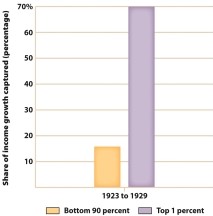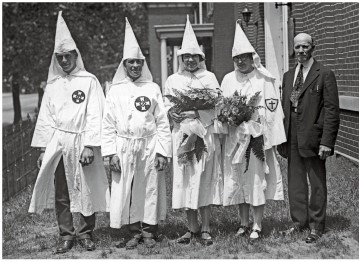A) The influence of Communists on the labor movement
B) Salaries being outpaced by inflation
C) Opposition to U.S. intervention in the Russian Revolution
D) Workers' frustration with growing income inequality
F) B) and D)
Correct Answer

verified
Correct Answer
verified
Multiple Choice
Charles Schenck was convicted of espionage in 1919 because he
A) protested American intervention in the Russian Revolution.
B) was a member of the Industrial Workers of the World.
C) urged Americans to oppose the military draft during World War I.
D) sent a mail bomb to the home of the attorney general of the United States.
F) A) and C)
Correct Answer

verified
Correct Answer
verified
Multiple Choice
During the 1920s, women who wore short skirts and makeup and enjoyed smoking, drinking, and dancing were called
A) New Negroes.
B) matinee idols.
C) suffragettes.
D) flappers.
F) All of the above
Correct Answer

verified
Correct Answer
verified
Multiple Choice
The impact of the new field of psychology on the American public was visible in the
A) motion picture industry's depiction of romance.
B) advertising industry's manipulation of consumers' fears and insecurities.
C) depiction of family life on popular radio programs.
D) disillusionment expressed in the writings of the Lost Generation.
F) B) and C)
Correct Answer

verified
Correct Answer
verified
Multiple Choice
Which of the following characterized the U.S. relationship with Western Europe in the wake of World War I?
A) The U.S. economy was strengthened because the European states had become indebted to it.
B) The destructions caused by the war made the European nations an ideal market for American manufacturers.
C) The U.S. economy was weakened by the European nations' inability to repay their war debts or purchase American goods.
D) The growth of the American consumer market meant that the U.S. economy could function independently of Europe's.
F) A) and C)
Correct Answer

verified
Correct Answer
verified
Multiple Choice
What made it possible for income inequality to grow during the 1920s, a period of apparent prosperity?
A) Government corruption scandals like Teapot Dome benefited the wealthy and hurt the poor.
B) Increased mechanization of factory work led to massive unemployment among unskilled laborers.
C) Corporate and governmental efforts to destroy labor unions resulted in lower wages among the working class.
D) Corporate profits grew much faster than wages did, so more wealth was accumulated by the already rich.
F) A) and C)
Correct Answer

verified
Correct Answer
verified
Multiple Choice
Who promoted the "Back to Africa" movement, which sought to move black Americans to their ancestral homelands?
A) W. E. B. Du Bois and the National Association for the Advancement of Colored People
B) D. C. Stephenson and the Ku Klux Klan
C) A. Philip Randolph and the African American labor movement
D) Marcus Garvey and the Universal Negro Improvement Association
F) A) and B)
Correct Answer

verified
Correct Answer
verified
Multiple Choice
What conclusion does Figure 21.2, Income Inequality, 1923-1929, permit? 
A) The bottom 90 percent held only 15 percent of the nation's wealth.
B) The top 1 percent held 15 percent of the nation's wealth.
C) The middle class was earning only 15 percent of the nation's income.
D) The richest 1 percent reaped most of the growth in income during the 1920s.
F) All of the above
Correct Answer

verified
Correct Answer
verified
Multiple Choice
The results of the 1928 presidential election reflected
A) a rural-urban divide over basic values.
B) the grassroots popularity of Herbert Hoover.
C) the political influence of the Ku Klux Klan.
D) the demise of the Progressive Party.
F) None of the above
Correct Answer

verified
Correct Answer
verified
Multiple Choice
Republican victory in the 1924 presidential election can be attributed to the split within the Democratic Party over
A) social welfare policy.
B) Darwin's theory of evolution.
C) farm relief.
D) prohibition.
F) C) and D)
Correct Answer

verified
Correct Answer
verified
Multiple Choice
Movie stars during the 1920s strongly promoted new
A) politics.
B) views on immigration.
C) fashions and hairstyles.
D) arts.
F) B) and C)
Correct Answer

verified
Correct Answer
verified
Multiple Choice
What does the image of the Ku Klux Klan wedding from 1925 (Document 21.2) reveal about the organization? 
A) It remained a southern organization.
B) It remained predominantly rural.
C) It had given up on white supremacist terrorism.
D) It had become a socially acceptable public organization.
F) All of the above
Correct Answer

verified
Correct Answer
verified
Multiple Choice
The research findings of Franz Boas and Ruth Benedict on race and culture supported the beliefs of
A) Henry Ford.
B) W. J. Simmons.
C) W. E. B. Du Bois.
D) E. P. Cubberly.
F) None of the above
Correct Answer

verified
Correct Answer
verified
Multiple Choice
What ended the wild speculation in Florida real estate during the late 1920s?
A) Lack of amenities for tourists
B) Rising gasoline prices
C) Bad weather
D) Rising land prices
F) None of the above
Correct Answer

verified
Correct Answer
verified
Multiple Choice
The Ku Klux Klan showed significant strength in which of the following cities?
A) Indianapolis, Indiana
B) Charleston, South Carolina
C) Memphis, Tennessee
D) Jackson, Mississippi
F) A) and B)
Correct Answer

verified
Correct Answer
verified
Showing 41 - 55 of 55
Related Exams